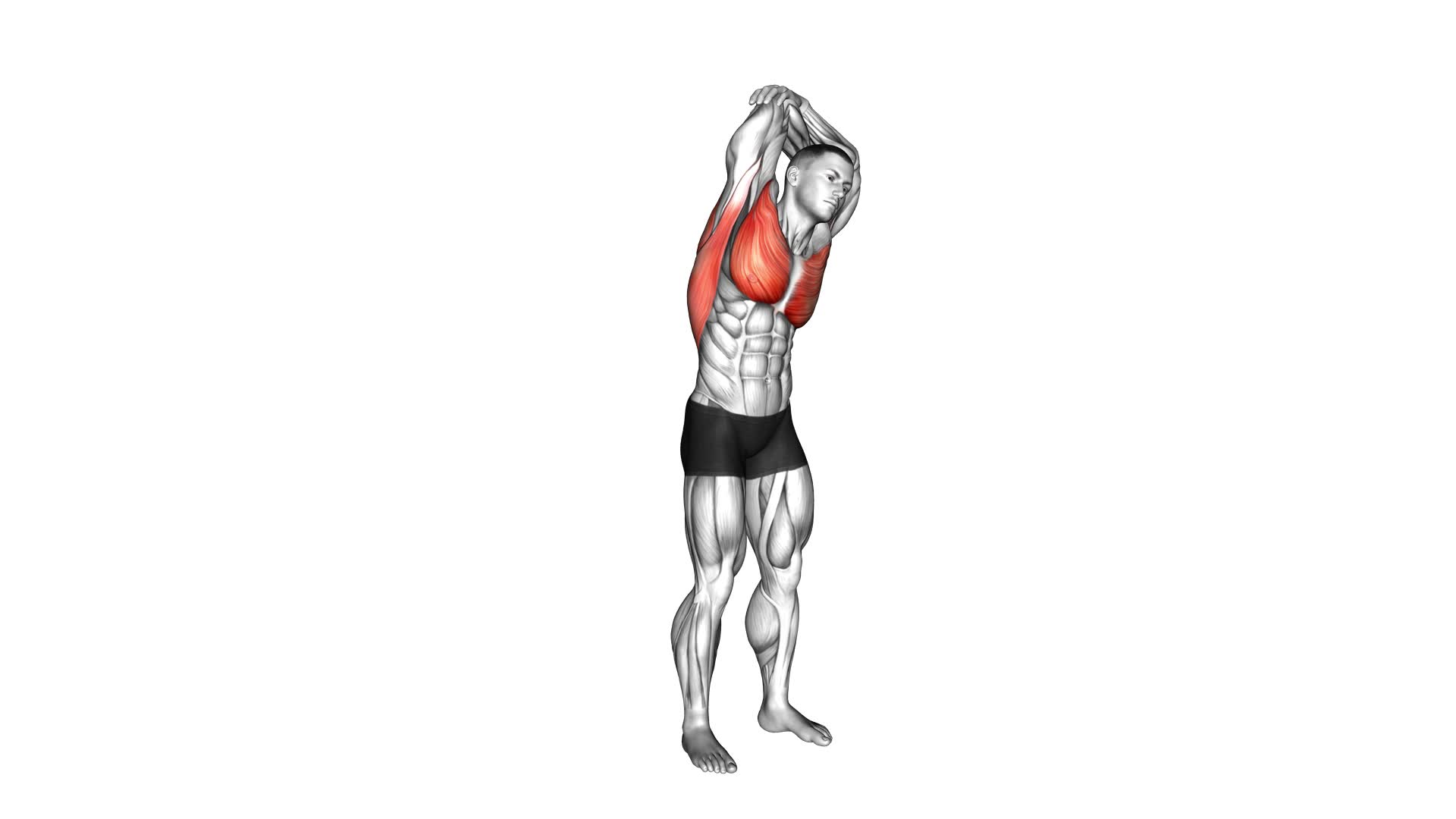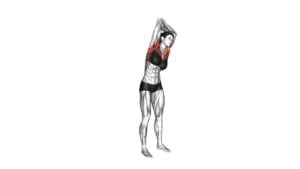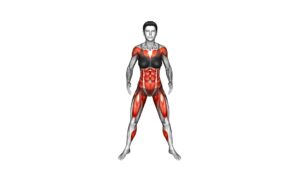Standing Reach-Up Back Rotation Stretch – Video Exercise Guide & Tips

Are you looking for a highly effective stretch that targets your back and improves flexibility? Look no further than the Standing Reach-Up Back Rotation Stretch!
Watch This Exercise Video
In this video exercise guide, we'll show you step-by-step how to perform this stretch correctly, along with valuable tips to ensure proper form and technique.
Whether you're a beginner or a seasoned fitness enthusiast, we've got you covered with modifications and variations to suit your fitness level.
Get ready to unlock a more limber and mobile back!
Key Takeaways
- The standing reach-up back rotation stretch improves flexibility and relieves lower back pain.
- The exercise targets the erector spinae muscles and increases mobility.
- It promotes blood flow for healing and relief and improves posture and releases tension.
- Proper form and technique, as well as listening to your body and modifying if needed, are important for safety and effectiveness.
Benefits of the Standing Reach-Up Back Rotation Stretch
Discover the numerous benefits of the Standing Reach-Up Back Rotation Stretch. This exercise is highly effective in improving flexibility and relieving lower back pain. By incorporating this stretch into your routine, you can experience significant improvements in your overall flexibility levels.
The Standing Reach-Up Back Rotation Stretch targets the muscles in your lower back, specifically the erector spinae muscles, which play a crucial role in maintaining proper spinal alignment and stability.
Improving flexibility is essential for maintaining a healthy range of motion in your spine. The Standing Reach-Up Back Rotation Stretch helps to lengthen and stretch the muscles in your lower back, allowing for increased mobility and reducing the risk of injury. Additionally, this exercise can help alleviate lower back pain by releasing tension in the muscles surrounding the spine. As you rotate and reach up, you promote blood flow to the area, which aids in the healing process and provides relief from discomfort.
Incorporating the Standing Reach-Up Back Rotation Stretch into your regular exercise routine can have long-lasting benefits for your overall well-being. Not only will you experience improved flexibility and reduced lower back pain, but you'll also enhance your posture and increase your core stability. Remember to perform this stretch with proper form and gradually increase the intensity over time for maximum results.
Equipment Needed for the Exercise
To perform the Standing Reach-Up Back Rotation Stretch, you'll need minimal equipment. This stretch requires a sturdy, stable surface such as a wall or a door frame. Stand facing the wall or door frame, making sure that there's enough space for you to extend your arms fully.
It's important to have proper form while performing this stretch to maximize its benefits and minimize the risk of injury. Stretching is an essential component of any fitness routine as it helps improve flexibility, increase range of motion, and prevent muscle imbalances. The Standing Reach-Up Back Rotation Stretch specifically targets the muscles in your back, shoulders, and chest. By incorporating this stretch into your routine, you can improve your posture and alleviate tension in these areas.
Proper form is crucial when performing the Standing Reach-Up Back Rotation Stretch. Start by standing tall with your feet shoulder-width apart. Keep your back straight and engage your core. As you reach up towards the wall or door frame, make sure to keep your shoulders relaxed and avoid shrugging them. As you rotate your torso, focus on maintaining a controlled movement and avoid any jerking or twisting motions. This will help protect your spine and ensure an effective stretch.
Now that you're familiar with the equipment needed and the importance of proper form, let's move on to the step-by-step guide to performing the Standing Reach-Up Back Rotation Stretch.
Step-by-Step Guide to Performing the Stretch
To perform the Standing Reach-Up Back Rotation Stretch, follow these step-by-step instructions. This stretch is an effective way to improve flexibility and prevent back pain.
- Stand with your feet shoulder-width apart and keep your knees slightly bent.
- Extend your arms straight above your head, interlacing your fingers with your palms facing upward.
- Inhale deeply as you reach up towards the ceiling, lengthening your spine and engaging your core.
- Exhale slowly as you rotate your torso to the right, keeping your hips and lower body stable.
- Hold the stretch for 20-30 seconds, feeling the gentle stretch along your spine and the muscles of your back.
- Inhale again and return to the starting position with your arms extended overhead.
- Exhale as you rotate your torso to the left, maintaining stability in your lower body.
- Hold this stretch for 20-30 seconds, focusing on maintaining proper form and feeling the stretch in your back.
- Repeat this stretch 2-3 times on each side, gradually increasing the duration of each hold.
- Transition into the next section to learn some helpful tips for proper form and technique.
By following these step-by-step instructions, you can perform the Standing Reach-Up Back Rotation Stretch effectively, improving your flexibility and preventing back pain.
Now, let's explore some tips for proper form and technique.
Tips for Proper Form and Technique
As you continue with the Standing Reach-Up Back Rotation Stretch, it's important to focus on maintaining proper form and technique. Doing so won't only maximize the benefits of the stretch but also minimize the risk of injury. One of the most common mistakes people make is rounding their back during the stretch. To avoid this, keep your spine straight and engage your core muscles to maintain stability. Another common mistake is shrugging your shoulders or tensing your neck. Instead, relax your shoulders and keep them down away from your ears.
Breathing techniques are also crucial to ensure proper form and technique. As you reach up and rotate your torso, inhale deeply through your nose, filling your lungs with air. This will help expand your ribcage and increase your range of motion. As you return to the starting position, exhale slowly through your mouth, releasing any tension or tightness in your muscles.
Remember to listen to your body and modify the stretch if needed. If you feel any pain or discomfort, reduce the intensity or stop the stretch altogether. It's better to prioritize safety and avoid pushing yourself too far.
Modifications and Variations for Different Fitness Levels
Continue adapting the Standing Reach-Up Back Rotation Stretch to suit your fitness level by exploring modifications and variations. Whether you're recovering from an injury or looking to challenge yourself at an advanced fitness level, there are options available to meet your specific needs.
Here are three modifications and variations to consider:
- Adaptations for injury recovery: If you're recovering from an injury, it's important to listen to your body and work within your limitations. You can try performing the stretch with a smaller range of motion or using a support, such as a wall or chair, to assist in maintaining balance. Additionally, you can focus on the seated version of the stretch to alleviate pressure on your lower body.
- Advanced progressions for advanced fitness levels: If you're looking to take your flexibility and mobility to the next level, there are advanced variations of the Standing Reach-Up Back Rotation Stretch that you can explore. One option is to incorporate resistance bands or weights to add an extra challenge to the exercise. Another option is to perform the stretch on an unstable surface, such as a balance board or foam pad, to engage your core muscles even more.
- Customizing the stretch for specific goals: Depending on your fitness goals, you can modify the stretch to target specific muscle groups. For example, if you want to focus on your hamstrings, you can perform the stretch with a slight bend in your knees. If you want to target your obliques, you can add a side bend to the rotation. By customizing the stretch, you can tailor it to meet your specific needs and desired outcomes.
Frequently Asked Questions
Can the Standing Reach-Up Back Rotation Stretch Help Improve Posture?
The standing reach-up back rotation stretch is a great exercise to improve your posture. By incorporating this stretch into your routine, you can reap the benefits of improved overall flexibility.
To execute the stretch properly and maximize its effectiveness, follow these steps:
- Stand tall with your feet hip-width apart.
- Reach your arms overhead.
- Rotate your torso from side to side.
This stretch targets the muscles in your back and helps to improve your posture.
Is It Normal to Feel a Stretch in the Shoulders While Performing the Exercise?
When performing the standing reach-up back rotation stretch, it's normal to feel a stretch in your shoulders. This exercise is designed to improve shoulder flexibility and increase range of motion.
To ensure you're getting the most out of this stretch, it's important to maintain proper form. Keep your back straight and engage your core muscles as you reach up and rotate your torso. This will help maximize the benefits of the exercise.
Can the Standing Reach-Up Back Rotation Stretch Help Alleviate Lower Back Pain?
The standing reach-up back rotation stretch can be beneficial for alleviating lower back pain. This exercise helps to improve flexibility in the back muscles and promotes better posture.
By stretching and strengthening the muscles in your back, you can reduce the strain on your lower back and potentially decrease pain.
However, it's important to note that there are also alternative exercises that can provide relief for lower back pain, such as pelvic tilts and cat-camel stretches.
Are There Any Precautions or Contraindications for Individuals With Existing Shoulder Injuries?
Before attempting the standing reach-up back rotation stretch, it's important to consider any precautions or contraindications, especially if you have existing shoulder injuries. Shoulder injuries can limit your range of motion and potentially worsen if not properly addressed during exercise.
It's advisable to consult with a healthcare professional or a qualified fitness instructor who can provide modifications or alternative stretches that are safer for your specific condition.
How Frequently Should the Standing Reach-Up Back Rotation Stretch Be Performed for Optimal Results?
To achieve optimal results from the standing reach-up back rotation stretch, it's important to consider the frequency at which you perform this exercise.
The standing reach-up back rotation stretch offers numerous benefits, such as improving flexibility and mobility in the upper body, enhancing posture, and relieving tension in the back and shoulders.
Conclusion
Incorporating the standing reach-up back rotation stretch into your fitness routine can have numerous benefits.
This exercise helps improve flexibility in the back muscles, promotes better posture, and enhances overall mobility.
It requires no equipment and can be easily modified to suit different fitness levels.
By following the step-by-step guide and maintaining proper form and technique, you can effectively stretch and strengthen your back muscles, leading to improved performance in various physical activities.

Author
Years ago, the spark of my life’s passion ignited in my mind the moment I stepped into the local gym for the first time. The inaugural bead of perspiration, the initial endeavor, the very first surge of endorphins, and a sense of pride that washed over me post-workout marked the beginning of my deep-seated interest in strength sports, fitness, and sports nutrition. This very curiosity blossomed rapidly into a profound fascination, propelling me to earn a Master’s degree in Physical Education from the Academy of Physical Education in Krakow, followed by a Sports Manager diploma from the Jagiellonian University. My journey of growth led me to gain more specialized qualifications, such as being a certified personal trainer with a focus on sports dietetics, a lifeguard, and an instructor for wellness and corrective gymnastics. Theoretical knowledge paired seamlessly with practical experience, reinforcing my belief that the transformation of individuals under my guidance was also a reflection of my personal growth. This belief holds true even today. Each day, I strive to push the boundaries and explore new realms. These realms gently elevate me to greater heights. The unique combination of passion for my field and the continuous quest for growth fuels my drive to break new ground.







